|
|
|
|
|
|
AMERICAN INDIAN |
|
|
|
|
|
|
|||||
|
|
||||||
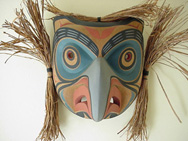 Click on image for more views |
Tony Hunt Jr. Northwest Coast Kwaguilth Owl Mask This hand-carved cedar mask was made by Tuny Hunt Jr. in 1988 and is signed by the artist, dated and titled "Kwagiulth Owl". It was purchased in a Northwest Coast Indian art gallery in Vancouver, B.C. in 1988 and has been in my collection since then. Dimensions are 9 1/4" high by 10 1/4" wide by 7" deep with cedar bark side tassels 15" long. Condition is excellent. Has a tiny dent on bridge of beak and tiny paint nick on left eye brow (see closeups). Otherwise in perfect condition. Has a strong cord fastened to two screw eyes on back for hanging (original to mask). Tony Hunt Jr. is a contemporary Northwest Coast Kwaguilth artist born in Victoria, B.C. in 1961. He comes from a lineage of master wood carvers going back to his great grandfather. He learned to carve from his father Tony Hunt Sr. His work has been exhibited widely and is sought by collectors world wide. To learn more about the artist and his work, here are some links to other sites which carry his work: http://www.alcheringa-gallery.com/artists.html?do=view&artist=50&offset=0 http://www.coghlanart.com/tony1.htm http://www.coastalarts.com |
Item #amin09
—SOLD— |
||||
|
|
|
|||||
 Click on image for more views |
Pre-1940 Regional Navajo Rug This Navajo Rug is made from all handspun wool, with two natural sheep colors, the white and grey, and three dyed colors, the red, black and light brown. The edging cords along the selvages and ends are made from light brown tightly twisted 2-ply handspun wool, giving this rug excellent strength, durability and protection from wear. These edging cords are one of the elements found on an authentic Navajo rug. Mexican imitations do not have these edging cords on the selvages or ends, and instead have a fringe on either end rather than the characteristic continuous warp loops bound by the edging cord of the real Navajo rug. The design of this rug is bold, with three columns of stacked diamonds, two of half diamonds against a ground of alternating neutral stripes. Condition of this rug is excellent, with only a few loose yarns, one 1/4 inch soil spot, and a few very small and almost unnoticeable stains on one side. No fading, red is still fully saturated and vivid. Can be used in the existing condition; no need for any restoration. The weave is medium-light weight, in between blanket and rug weight, but leaning towards the rugs weight. Size is 45 inches by 72 inches. Note: rug is actually square. (see 'rugs' link for more selection of rugs) |
Item #amin07
$850 |
||||
|
|
||||||
|
|
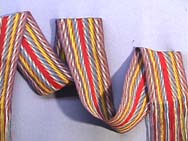 Click on image for more views |
Mid-Late 19th C. American Indian Assumption Sash Date: c.1860-1880 Size: 76" x 6" plus 24" fringe at both ends making total length 124". Condition: excellent, no holes, a broken thread along one selvage. These sashes were woven by the Lakes and Northeastern tribes. This earlier one is finger-woven or plaited without a loom from hand-spun vegetal-dyed wool, including two shades of indigo. They were originally used as a major clothing item to add color to the costume and later traded with the voyagers, who used the sash to wrap around their mid-section when carrying heavy loads of cargo on their portages west through the St. Lawrence Seaway to the Great Lakes region. This is a very fine example of one of these sashes which is expertly woven and the color palette is beautifully harmonized. Technique: double-plaited. |
|
Item #amin06
—SOLD— |
||
|
|
|
|||||
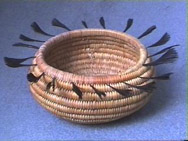 Click on image for more views |
Early 20th Century Coiled Pomo Feather Basket
This small bowl-shaped basket is from the Central California region, where the Pomo tribe produced both twined and coiled baskets. The Pomo in particular made some of the finest baskets of any region. Their forms were diverse, their techniques were excellent and they had a variety of designs. This basket was once covered with feathers, probably mallard or woodpecker. One can see the feather stubs between each stitch. They were probably eaten away by insects, yet the quail feathers were oddly left intact, and the coiling left untouched. Size is: 1 1/4" high x 2 1/2" diameter. Materials: willow warp, sedge root coil, quail feathers. |
Item #amin02
—SOLD— |
||||
|
|
||||||
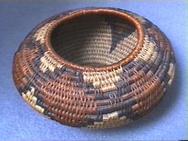 Click on image for more views |
Early 20th C. Coiled Arts & Crafts Indian-Style Basket Date: early 20th C. Size: 2 1/8" high x 4 3/4" at the widest mid-section Condition: excellent, nice patina Although likely not an Indian basket, the quality is fine and it is an earlier piece. It is coiled in the lazy stitch which is not traditionally an Indian basketry technique but rather a 20th C. adaptation which was taught in early arts and crafts classes and workshops. Handmade baskets were popular in Arts & Crafts interiors as were Navajo rugs and Southwest and art pottery. This basket appears to be made of sisal and naturally dyed. It is very well-made. The stitching and design are masterfully integrated, and it is very sturdy in construction. It is 2 1/8" high x 4 3/4" at the widest mid-section. It was likely made in the 1920's-30's. It is a lovely little basket and would certainly enhance any serious basket collection. |
Item #amin03
$125 |
||||
|
|
||||||
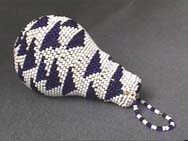 Click on image for more views |
Vintage American Indian Beaded Light Bulb Date: 1930-1950's Size: standard light bulb Condition: excellent This is really a novelty item, a conversation piece! It was purchased 5 or 6 years at an American Indian Antique Art auction. A more common item one finds is the beaded bottle, but I have yet to see another light bulb. It is probably a practice piece for someone learning beadwork, as it takes quite a bit of skill to get a beaded pattern to come out evenly over a three-dimensional form. The piece is done in 2 colors, cobalt blue and white, the blue beads being transparent and the white beads being opaque. There is a beaded loop at the end of the bulb indicating it could be hung as a decorative object. Size is that of a standard light bulb. |
Item #amin01
—SOLD— |
||||
|
|
||||||
 Click on image for more views |
Mid-20th C. Huichol Indian Shaman Ritual Embroidered Cloth Date: 1940-1960's Size: 27 1/2" x 32 1/2" Condition: excellent Origin: Huichol or possibly other native group in Mexico. The Huichol, one of the few Indian groups of Mesoamerica that has managed to preserve their indigenous religion, inhabit the Sierra Madre of Western Mexico. Their Cosmic Center is located in the desert of San Luis Potosi and is called Wirikuta, land of the divine ancestors—place of the sacred peyote—where a person must journey at least five times before he can become a shaman, or a mara'akame. These yarn images, or nearika (meaning 'face', 'aspect', 'design'), are considered expressions of their ceremonial art, depicting the many aspects of the shamans journy into the Other World. (Ripinsky-Naxon). The subject of this embroidered piece is a visionary journey encountering beings in the three worlds connected by the World Tree. These visions, induced by drinking alcohol or ingesting peyote, were part of the shamans healing journey. The figure with the hat, perhaps the shaman, lassoes a fallen spirit in order to subdue it's negative influences over the human beings. The colors are very vibrant and the beings depicted are both whimsical and pesky. The large bird in the center must be the shamans helper. Today, these visionary images are still made but as paintings of yarn embedded in beeswax rather than embroidered. These older embroidered pieces were much more time-consuming to make. This one interestingly has a small embroidered line in the lower right corner reminding me of the spirit lines sometimes woven into Navajo rugs so the maker's spirit will not become trapped in the image. Materials are cotton muslin fabric, colored embroidery thread. |
Item #amin029
—SOLD— |
||||
|
|
||||||
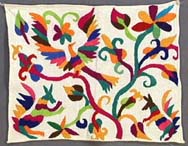 Click on image for more views |
Mid-20th C. Huichol Indian Shaman Ritual Embroidered Cloth Date:1940-1960's Size:10" x 13" Condition: excellent Origin: Huichol or possibly other native group in Mexico. (see desription above for general info. on Huichol traditions). The subject is a visionary dream of flowering World Tree and with a fantastic bird of multi-colored plumage perching in the branches ready to take flight to the upper world, and two fantastic-looking creatures sitting at the base of the tree. The colors are very festive and cheerful. It is a lovely little work of art. |
Item #amin030
$135 |
||||
|
|
||||||
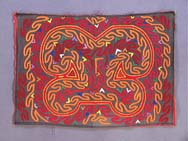 Click on image for more views |
Vintage Mola Hand-Sewn Needlework Appliqué Date: 1950's - 1960's Size: 16" x 23" Description: Molas were and are made by the San Blas Cuna Indians of Panama. It is a very intriqite pattern of multi-colored and multi-layered pieces of appliiquéd cloth, each edge hand-sewn in place stitch by stitch. Many of the newer ones you see today are of animals, but this one is a symbolic abstracted shape. It has a very nice old patina, the cloth faded just so to give it a lovely soft quality. |
Item # txt028
—SOLD— |
||||
|
|
||||||
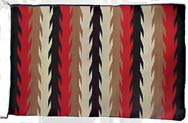 Click on image for more views |
Pre-1940 Regional Navajo Rug Date: 1920 - 1940 Size: 29" x 44" Warp ends per inch: 8 epi Weft ends per inch: 52 ppi (picks per inch Materials: handspun wool warp and weft Condition: Overall very good condition. One corner has a 2" by 3" old fabric patch machine sewn on to protect the yarn from unraveling, where some of the yarns are broken. There are a few faint yellowish stains in the center, which is very common in pieces of this age, as this was a rug which was used in the household of a Navajo family who owned speep and dogs and likely lived in a hogan. Other features: both selvages are bound with the edging yarn (see photos). Both ends have the double twisted warp binding cords which hold the warp on the loom when woven. These edging cords on all four sides not only gives the rug more durability from wear and tear, but are also essential elements of an authentic Navajo rug. This is a very finely woven Navajo rug, finer than most older rugs that you find. 52 weft picks per inch is not very common, except in the better quality pieces. Most Navajo rugs were woven with much thicker weft yarn. All the colors are natural except obviously the red. The light brown is a less common natural color Keywords: american indian, native american, south west weaving |
Item # rug03
$495 |
||||
|
|
|
|
|
|||
|
|
|
|
|
|||
|
|